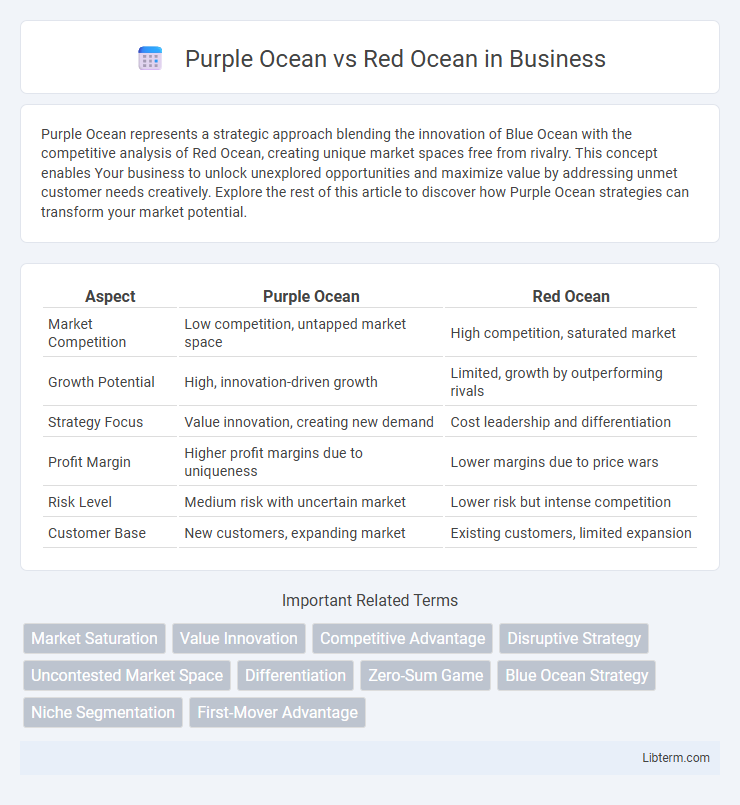Purple Ocean represents a strategic approach blending the innovation of Blue Ocean with the competitive analysis of Red Ocean, creating unique market spaces free from rivalry. This concept enables Your business to unlock unexplored opportunities and maximize value by addressing unmet customer needs creatively. Explore the rest of this article to discover how Purple Ocean strategies can transform your market potential.
Table of Comparison
| Aspect | Purple Ocean | Red Ocean |
|---|---|---|
| Market Competition | Low competition, untapped market space | High competition, saturated market |
| Growth Potential | High, innovation-driven growth | Limited, growth by outperforming rivals |
| Strategy Focus | Value innovation, creating new demand | Cost leadership and differentiation |
| Profit Margin | Higher profit margins due to uniqueness | Lower margins due to price wars |
| Risk Level | Medium risk with uncertain market | Lower risk but intense competition |
| Customer Base | New customers, expanding market | Existing customers, limited expansion |
Understanding Purple Ocean vs Red Ocean Strategies
Purple Ocean strategies blend the competitive nature of Red Ocean markets with innovative value creation, aiming to outperform rivals by expanding market boundaries rather than competing head-to-head. Red Ocean strategies focus on capturing existing demand within saturated markets, where businesses engage in cutthroat competition, often resulting in price wars and shrinking profit margins. Understanding these strategic approaches enables companies to decide between competing in crowded industries or creating new market spaces through product innovation and differentiation.
Key Characteristics of Purple Ocean Markets
Purple Ocean markets blend elements from both Red Ocean and Blue Ocean, featuring competitive yet innovative landscapes where businesses differentiate through unique value propositions. These markets prioritize collaboration and niche targeting, allowing companies to coexist while minimizing direct competition. Key characteristics include moderate competition, continuous innovation, and targeted customer segmentation enabling sustainable growth.
Defining Features of Red Ocean Competition
Red Ocean competition is characterized by saturated markets where businesses fiercely compete for existing demand, leading to price wars and reduced profit margins. Companies operate within well-defined industry boundaries, offering similar products or services, which intensifies rivalry and limits growth opportunities. Strategic focus centers on outperforming rivals through incremental improvements rather than creating new market space.
Advantages of Purple Ocean Strategy
Purple Ocean Strategy combines the innovation of Blue Ocean with competitive advantages of Red Ocean markets, creating unique value while leveraging existing demand. It enables businesses to differentiate products or services within a contested market, reducing direct competition while capturing loyal customers. This hybrid approach maximizes growth potential and profitability by exploiting untapped opportunities without abandoning core market strengths.
Limitations of Red Ocean Approach
The Red Ocean approach faces significant limitations, including intense competition that drives down profits and market saturation that hinders innovation. Companies operating in Red Oceans often struggle with price wars and diminishing returns due to the zero-sum nature of existing markets. This approach restricts growth opportunities by focusing solely on outperforming rivals rather than creating new demand or exploring untapped market spaces.
How to Create a Purple Ocean Opportunity
Creating a Purple Ocean opportunity involves blending the competitive strategies of Red and Blue Oceans by innovating within existing markets while expanding into untapped demand. Businesses analyze current market boundaries to identify unmet customer needs and deliver unique value propositions that differentiate from competitors and attract new segments. Implementing value innovation, strategic differentiation, and focused market segmentation enables companies to shift from saturated, price-driven Red Oceans to dynamic, growth-driven Purple Oceans.
Case Studies: Purple Ocean Success Stories
Case studies of Purple Ocean success stories highlight companies like Tesla, which created uncontested market space by integrating luxury electric vehicles with sustainable energy solutions, diverging from the fierce competition of traditional automotive markets. Airbnb revolutionized the hospitality industry by blending social networking with lodging services, establishing a unique customer experience beyond the conventional hotel sector. These examples demonstrate how Purple Ocean strategies leverage innovation and differentiation to capture new demand and reshape industry boundaries effectively.
Common Pitfalls in Red Ocean Environments
Red Ocean environments often suffer from intense competition where businesses compete in saturated markets, leading to price wars and reduced profit margins. Common pitfalls include targeting the same customer base as competitors, resulting in diminished differentiation and limited growth opportunities. Companies frequently overlook innovation, leading to commoditization and a struggle to maintain market share.
Transitioning from Red Ocean to Purple Ocean
Transitioning from a Red Ocean to a Purple Ocean requires businesses to shift from fierce competition in saturated markets toward innovative value creation that blends differentiation and low cost. This strategic move emphasizes identifying uncontested market spaces by integrating creativity, customer insights, and technology to generate unique offerings. Companies adopting Purple Ocean strategies unlock new demand and sustainable growth by breaking away from zero-sum competition and fostering collaboration-driven ecosystems.
Choosing the Right Ocean Strategy for Your Business
Choosing the right ocean strategy involves identifying market space where your business can thrive with minimal competition, known as a Purple Ocean, a blend of Blue and Red Ocean strategies emphasizing innovation and competitive advantage. Purple Ocean strategies balance differentiation with cost leadership, enabling companies to create new demand while maintaining competitive pricing, unlike Red Ocean strategies that focus solely on competing in existing markets. Successful businesses analyze industry trends, customer needs, and competitor dynamics to determine whether to compete aggressively in crowded markets or explore untapped opportunities for sustainable growth.
Purple Ocean Infographic

 libterm.com
libterm.com